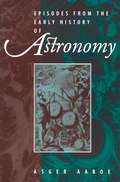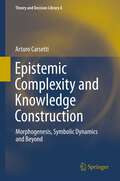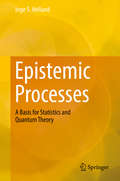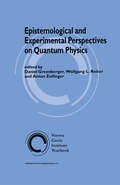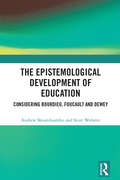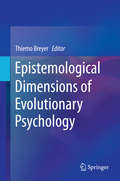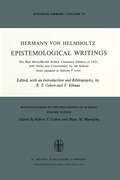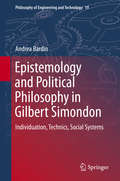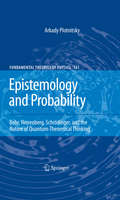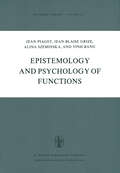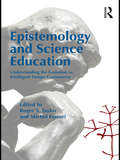- Table View
- List View
Epilepsy as a Dynamic Disease (Biological and Medical Physics, Biomedical Engineering)
by John Milton Peter JungThe first book to bring together experts in epilepsy, bio-engineering and dynamical systems theory, to discuss the possibility of treating epilepsy by controlling mechanisms that cause seizures. It includes a unique reference database with more than 1000 references, including hard-to-access references in the Russian literature.
Epilepsy Surgery and Intrinsic Brain Tumor Surgery: A Practical Atlas
by Konstantinos Fountas Eftychia Z. KapsalakiThis book provides a comprehensive and practical guide for the safe and efficient management of patients with intrinsic brain tumors and medically intractable epilepsy. It presents in an easily understandable way the preoperative evaluation of these patients, starting from the clinical interpretation of conventional anatomical MR imaging and analyses the clinical significance of newer MR based imaging techniques such as diffusion and perfusion imaging. It demonstrates with clarity the role of MR spectroscopy and fractional anisotropy and diffusion tensor imaging in the preoperative assessment of these patients and how this data can be incorporated into the surgical planning. This book is aimed at neurosurgeons, neuroradiologists, neurologists, and epileptologists, and may also be of interest to neuropsychologists, neurophysiologists, radiation oncologists, and medical physicists.
Epileptic Seizures and the EEG: Measurement, Models, Detection and Prediction
by Mark Cook Andrea Varsavsky Iven MareelsAnalysis of medical data using engineering tools is a rapidly growing area, both in research and in industry, yet few texts exist that address the problem from an interdisciplinary perspective. Epileptic Seizures and the EEG: Measurement, Models, Detection and Prediction brings together biology and engineering practices and identifies the aspects o
Epileptic Seizures and the EEG: Measurement, Models, Detection and Prediction
by Mark Cook Andrea Varsavsky Iven MareelsA study of epilepsy from an engineering perspective, this volume begins by summarizing the physiology and the fundamental ideas behind the measurement, analysis and modeling of the epileptic brain. It introduces the EEG and provides an explanation of the type of brain activity likely to register in EEG measurements, offering an overview of how these EEG records are and have been analyzed in the past. The book focuses on the problem of seizure detection and surveys the physiologically based dynamic models of brain activity. Finally, it addresses the fundamental question: can seizures be predicted? Based on the authors' extensive research, the book concludes by exploring a range of future possibilities in seizure prediction.
Epioptics: Linear and Nonlinear Optical Spectroscopy of Surfaces and Interfaces (ESPRIT Basic Research Series)
by John F. McGilp Denis Weaire Charles PattersonThe study of condensed matter using optical techniques, where photons act as both probe and signal, has a long history. It is only recently, however, that the extraction of surface and interface information, with submonolayer resolution, has been shown to be possible using optical techniques (where "optical" applies to electromagnetic radiation in and around the visible region of the spectrum). This book describes these "epioptic" techniques, which have now been quite widely applied to semiconductor surfaces and interfaces. Particular emphasis in the book is placed on recent studies of submonolayer growth on well-characterised semiconductor surfaces, many of which have arisen from CEC DGJGII ESPRIT Basic Research Action No. 3177 "EPIOPTIC", and CEU DGIII ESPRIT Basic Research Action No. 6878 "EASI". Techniques using other areas of the spectrum such as the infra-red region (IR spectroscopy, in its various surface configurations), and the x-ray region (surface x-ray diffraction, x-ray standing wave), are omitted. The optical techniques described use simple lamp or small laser sources and are thus, in principle, easily accessible. Epioptic probes can provide new information on solid-gas, solid-liquid and liquid-liquid interfaces. They are particularly suited to growth monitoring. Emerging process technologies for fabricating submicron and nanoscale semiconductor devices and novel multilayer materials, whether based on silicon or compound semiconductors, all require extremely precise control of growth at surfaces. In situ, non-destructive, real-time monitoring and characterisation of surfaces under growth conditions is needed for further progress. Both atomic scale resolution, and non-destructive characterisation of buried structures, are required.
Episodes From the Early History of Astronomy
by Asger AaboePhenomena in the heavens are of great importance to many, and much of the lore of astronomy and astrology dates back to the earliest days of civilisation. The astronomy of the ancients is thus of interest not only as history but also as the basis for much of what is known or believed about the heavens today. This book discusses important topics in Babylonian and Greek astronomy.
Episodes from the History of the Rare Earth Elements (Chemists and Chemistry #15)
by C. H. Evans3. 4. 2. "SOMETHING ON CERIUM . . . . . . . . . . . . . . . . . . . . . . . . . . . . . . . . . . . . . . . . . . . . . . . . . . . . . . . . . . . . . . . 41 3. 4. 3. THE DISCOVERY OF LANTHANUM . . . . . . . . . . . . . . . . . . . . . . . . . . . . . . . . . . . . . . . . . . . . . . . . 42 3. 4. 4. THE DISCOVERY OF DIDYMIUM . . . . . . . . . . . . . . . . . . . . . . . . . . . . . . . . . . . . . . . . . . . . . . . . . . . . 45 3. 4. 5. THE NAME DIDYMIUM . . . . . . . . . . . . . . . . . . . . . . . . . . . . . . . . . . . . . . . . . . . . . . . . . . . . . . . . . . . . . . . . . . . . . 48 3. 4. 6. THE DISCOVERY OF TERBIUM AND ERBIUM . . . . . . . . . . . . . . . . . . . . . . . . . . . . . . 49 3. 5. The Cork Paper . . . . . . . . . . . . . . . . . . . . . . . . . . . . . . . . . . . . . . . . . . . . . . . . . . . . . . . . . . . . . . . . . . . . . . . . . . . . . . . . . . . . . . . . . . . . . 50 3. 6. Notes . . . . . . . . . . . . . . . . . . . . . . . . . . . . . . . . . . . . . . . . . . . . . . . . . . . . . . . . . . . . . . . . . . . . . . . . . . . . . . . . . . . . . . . . . . . . . . . . . . . . . . . . . . . . . 51 3. 7. References . . . . . . . . . . . . . . . . . . . . . . . . . . . . . . . . . . . . . . . . . . . . . . . . . . . . . . . . . . . . . . . . . . . . . . . . . . . . . . . . . . . . . . . . . . . . . . . . . . . . . 53 Chapter 4. THE 50 YEARS FOLLOWING MOSANDER . . . . . . . . . . . . . . . . . . . . . . . . . . . . . . . . . . . . . . 55 F. SZABADVARY and C. EVANS . . . . . . . . . . . . . . . . . . . . . . . . . . . . . . . . . . . . . . . . . . . . . . . . . . . . . . . . . . . . . . . . . . . . . 55 4. 1. Introduction . . . . . . . . . . . . . . . . . . . . . . . . . . . . . . . . . . . . . . . . . . . . . . . . . . . . . . . . . . . . . . . . . . . . . . . . . . . . . . . . . . . . . . . . . . . . . . . . . . 55 4. 2. The Terbium Dispute . . . . . . . . . . . . . . . . . . . . . . . . . . . . . . . . . . . . . . . . . . . . . . . . . . . . . . . . . . . . . . . . . . . . . . . . . . . . . . . . . . . 55 4. 3. Samarium and Others . . . . . . . . . . . . . . . . . . . . . . . . . . . . . . . . . . . . . . . . . . . . . . . . . . . . . . . . . . . . . . . . . . . . . . . . . . . . . . . . . . . 59 4. 4. The Division of Erbium . . . . . . . . . . . . . . . . . . . . . . . . . . . . . . . . . . . . . . . . . . . . . . . . . . . . . . . . . . . . . . . . . . . . . . . . . . . . . . . . 60 4. 5. Separating the Twins . . . . . . . . . . . . . . . . . . . . . . . . . . . . . . . . . . . . . . . . . . . . . . . . . . . . . . . . . . . . . . . . . . . . . . . . . . . . . . . . . . . . 62 4. 6. Conclusions . . . . . . . . . . . . . . . . . . . . . . . . . . . . . . . . . . . . . . . . . . . . . . . . . . . . . . . . . . . . . . . . . . . . . . . . . . . . . . . . . . . . . . . . . . . . . . . . . . 64 4. 7. References . . . . . . . . . . . . . . . . . . . . . . . . . . . . . . . . . . . . . . . . . . . . . . . . . . . . . . . . . . . . . . . . . . . . . . . . . . . . . . . . . . . . . . . . . . . . . . . . . . . . 65 Chapter 5. ELEMENTS NO. 70, 71 AND 72: DISCOVERIES AND CONTROVERSIES . . . . . . . . . . . . . . . . . . . . . . . . . . . . . . . . . . . . . . . . . . . . . . . . . . . . . . . . . . . . . . . . . . . . . . . . . . . . . . . . . . . . . . . . . . . . . . . . . . 67 HELGE KRAGH . . . . . . . . . . . . . . . . . . . . . . . . . . . . . . . . . . . . . . . . . . . . . . . . . . . . . . . . . . . . . . . . . . . . . . . . . . . . . . . . . . . . . . . . . . . . . . . . . . 67 5. 1. Introduction . . . . . . . . . . . . . . . . . . . . . . . . . . . . . . . . . . . . . . . . . . . . . . . . . . . . . . . . . . . . . . . . . . . . . . . . . . . . . . . . . . . . . . . . . . . . . . . . . . 67 5. 2. The ytterbium earths unti11905 . . . . . . . . . . . . . . . . . . . . . . . . . . . . . . . . . . . . . . . . . . . . . . . . . . . . . . . . . . . . . . . . . . . 68 5. 3. Auer von Welsbach: aldebaranium and cassiopeium . . . . . . . . . . . . . . . . . . . . . . . . . . . . . . . . . . .
Episodes in the Mathematics of Medieval Islam
by J.L. BerggrenThis book presents an account of selected topics from key mathematical works of medieval Islam, based on the Arabic texts themselves. Many of these works had a great influence on mathematics in Western Europe. Topics covered in the first edition include arithmetic, algebra, geometry, trigonometry, and numerical approximation; this second edition adds number theory and combinatorics. Additionally, the author has included selections from the western regions of medieval Islam—both North Africa and Spain. The author puts the works into their historical context and includes numerous examples of how mathematics interacted with Islamic society.
Epistemic Analysis: A Coherence Theory of Knowledge (Synthese Library #173)
by Paul ZiffTHIS ESSAY was begun a long time ago, in 1962, when I spent a year in Rome on a Guggenheim Fellowship. That twenty one years were required to complete it is owing both to the character of the theory presented and to my peculiar habits of mind. The theory presented is a coherence theory of knowledge: the con ception of coherence is here dominant and pervasive. But considera tions of coherence dictate an attention to details. The fact of the matter is that I get hung up on details: everything must fit, and if it does not, I do not want to proceed. A second difficulty was that all the epistemological issues seemed too clear. That may sound weird, but that's the way it is. I write philosophy to make things clear to myself. If, rightly or wrongly, I think I know the answer to a question, I can't bring myself to write it down. What happened, in this case, is that I finally became persuaded, in the course of lecturing on epistemology to under graduates, that not everything was as clear as it should be, that there were gaps in my presentation that were seriously in need of filling.
Epistemic Complexity and Knowledge Construction: Morphogenesis, symbolic dynamics and beyond (Theory and Decision Library A: #45)
by A. CarsettiThe volume as its first target aims at clarifying that peculiar entanglement of complexity, causality, meaning, emergence and intentionality that characterises the unfolding of the "natural forms" of human cognitionAs is well known, cognition is not only a self-organising process. It is also a co-operative and coupled process. If we consider the external environment as a complex, multiple and stratified Source which interacts with the nervous system, we can easily realise that the cognitive activities devoted to the "intelligent" search for the depth information living in the Source, may determine the very change of the complexity conditions according to which the Source progressively expresses its "wild" action. In this sense, simulation models are not neutral or purely speculative: the true cognition actually appears to be necessarily connected with successful forms of reading, those forms, in particular, that permit a specific coherent unfolding of the deep information content of the Source. Therefore, the simulation models, if valid, materialise as "creative" channels, i.e., as autonomous functional systems, as the very roots of a new possible development of the entire system represented by mind and its Reality. From a general point of view, the objectivity of Reality is also proportionate to the autonomy reached by cognitive processes. In this sense, at the level of cultural evolution, reference procedures act as guide, mirror and canalisation with respect to primary information flows and involved selective forces: they offer themselves as the actual instruments for the constant renewal of the code, for the invention and the actual articulation of an ever-new incompressibility. From an effective point of view, they appear as indissolubly linked to the successive definition of specific (and innovative) measures of the epistemic complexity. These measures cannot concern only statistical rarity (Shannon) or computational incompressibility (Kolmogorov-Chaitin), on the contrary they should also be able to take into account the coupled connection between the Source and the cognitive agent, the evolution of this connection as well as the successive constitution of meaning as symbolic form. Hence the possible (and necessary) definition of new axiomatic systems, new measure spaces, the real displaying of processes of continuous reorganisation at the semantic level. Indeed, it is only through a complete, first-order "reduction" and a correlated non-standard second-order analysis that new incompressibility will actually manifest itself. Therefore, the reference procedures appear to be related to a process of multiplication of minds, as well as to a process of "clarification" of meanings which finally emerges as vision via principles.
An Epistemic Foundation for Scientific Realism: Defending Realism Without Inference To The Best Explanation (Synthese Library #402)
by John WrightThis monograph develops a new way of justifying the claims made by science about phenomenon not directly observable by humans, such as atoms and black holes. It details a way of making inferences to the existence and properties of unobservable entities and states of affairs that can be given a probabilistic justification. The inferences used to establish realist claims are not a form of, and neither do they rely on, inference to the best explanation. Scientific Realism maintains that scientific theories and hypotheses refer to real entities, forces, and relations, even if one cannot examine them. But, there are those who doubt these claims. The author develops a novel way of defending Scientific Realism against a range of influential attacks. He argues that in some cases, at least, we can make probabilistically justifiable inferences from observed data to claims about unobservable, theoretical entities. He shows how this enables us to place some scientific realist claims on a firmer epistemological footing than has previously been the case. This also makes it possible to give a unified set of replies to the most common objections to Scientific Realism. The final chapters apply the developed conceptual apparatus to key cases from the history of science and from recent science. One example concerns realism with respect to atoms. Another looks at inferences from recent astronomical data to conclusions about the size and shape of those parts of the universe lying beyond that which we can observe.
Epistemic Processes: A Basis for Statistics and Quantum Theory
by Inge S. HellandThis book discusses a link between statistical theory and quantum theory based on the concept of epistemic processes – which can be e.g. statistical investigations or quantum mechanical measurements, and refer to processes that are used to gain knowledge about something. The book addresses a range of topics, including a derivation of the Born formula from reasonable assumptions, a derivation of the Schrödinger equation in the one-dimensional case, and a discussion of the Bell inequality from an epistemic perspective. The book describes a possible epistemic foundation of quantum theory. Lastly, it presents a general philosophical discussion of the approach, which, principally speaking, is not restricted to the micro-world. Hence the book can also be seen as a motivation for further research into quantum decision theory and quantum models for cognition. The book will benefit a broad readership, including physicists and statisticians interested in the foundation of their disciplines, philosophers of science and graduate students, and anyone with a reasonably good background in mathematics and an open mind.
Epistemic Processes: A Basis for Statistics and Quantum Theory
by Inge S. HellandThis book discusses a link between statistical theory and quantum theory based on the concept of epistemic processes. The latter are processes, such as statistical investigations or quantum mechanical measurements, that can be used to obtain knowledge about something. Various topics in quantum theory are addressed, including the construction of a Hilbert space from reasonable assumptions and an interpretation of quantum states. Separate derivations of the Born formula and the one-dimensional Schrödinger equation are given. In concrete terms, a Hilbert space can be constructed under some technical assumptions associated with situations where there are two conceptual variables that can be seen as maximally accessible. Then to every accessible conceptual variable there corresponds an operator on this Hilbert space, and if the variables take a finite number of values, the eigenspaces/eigenvectors of these operators correspond to specific questions in nature together with sharp answers to these questions. This paves a new way to the foundations of quantum theory. The resulting interpretation of quantum mechanics is related to Hervé Zwirn's recent Convivial Solipsism, but it also has some relations to Quantum Bayesianism and to Rovelli's relational quantum mechanics. Niels Bohr's concept of complementarity plays an important role. Philosophical implications of this approach to quantum theory are discussed, including consequences for macroscopic settings.The book will benefit a broad readership, including physicists and statisticians interested in the foundations of their disciplines, philosophers of science and graduate students, and anyone with a reasonably good background in mathematics and an open mind.
Epistemic Relativism: A Constructive Critique
by M. SeidelMarkus Seidel provides a detailed critique of epistemic relativism in the sociology of scientific knowledge. In addition to scrutinizing the main arguments for epistemic relativism he provides an absolutist account that nevertheless aims at integrating the relativist's intuition.
Epistemic Virtues in the Sciences and the Humanities (Boston Studies in the Philosophy and History of Science #321)
by Jeroen Van Dongen Herman PaulThis book explores how physicists, astronomers, chemists, and historians in the late nineteenth and early twentieth centuries employed ‘epistemic virtues’ such as accuracy, objectivity, and intellectual courage. In doing so, it takes the first step in providing an integrated history of the sciences and humanities. It assists in addressing such questions as:What kind of perspective would enable us to compare organic chemists in their labs with paleographers in the Vatican Archives, or anthropologists on a field trip with mathematicians poring over their formulas?While the concept of epistemic virtues has previously been discussed, primarily in the contexts of the history and philosophy of science, this volume is the first to enlist the concept in bridging the gap between the histories of the sciences and the humanities. Chapters research whether epistemic virtues can serve as a tool to transcend the institutional disciplinary boundaries and thus help to attain a ‘post-disciplinary’ historiography of modern knowledge. Readers will gain a contextualization of epistemic virtues in time and space as the book shows that scholars themselves often spoke in terms of virtue and vice about their tasks and accomplishments. This collection of essays opens up new perspectives on questions, discourses, and practices shared across the disciplines, even at a time when the neo-Kantian distinction between sciences and humanities enjoyed its greatest authority. Scholars including historians of science and of the humanities, intellectual historians, virtue epistemologists, and philosophers of science will all find this book of particular interest and value.
Epistemological and Experimental Perspectives on Quantum Physics (Vienna Circle Institute Yearbook #7)
by Daniel Greenberger W. L. Reiter Anton ZeilingerFrom the very beginning it was realised that quantum physics involves radically new interpretative and epistemological consequences. While hitherto there has been no satisfactory philosophical analysis of these consequences, recent years have witnessed the accomplishment of many experiments to test the foundations of quantum physics, opening up vistas to a completely novel technology: quantum technology. The contributions in the present volume review the interpretative situation, analyze recent fundamental experiments, and discuss the implications of possible future technological applications. Readership: Analytic philosophers (logical empiricists), scientists (especially physicists), historians of logic, mathematics and physics, philosophers of science, and advanced students and researchers in these fields. Can be used for seminars on theoretical and experimental physics and philosophy of science, and as supplementary reading at advanced undergraduate and graduate levels.
The Epistemological Development of Education: Considering Bourdieu, Foucault and Dewey
by Andrew Skourdoumbis Scott WebsterThis book documents the political and economic ramifications of the policy impetus for a ‘science of education’ and what this means for classroom teachers, their teaching practices and for the field of education. In a critical exploration of current research and policy articulations of the purposes of education, with attention given to Australia, the UK and the USA, this book delineates the evaluative mechanisms involved in the strategic science as method adoption of accountability, competitiveness and test-driven criteria used in major education policy. It brings together the disciplines of sociology and philosophy by drawing on the theoretical insights of Michel Foucault, Pierre Bourdieu and John Dewey. In addition, the book argues for the deliberate use of the theoretical in education and is against the contemporary unquestioning advocacy that often accompanies a narrowly defined master narrative of a science of education. This book will be of special interest to post-graduate students as source material in general education courses and is also intended for academics with an interest in educational theory/philosophy and the sociology of education.
The Epistemological Development of Education: Considering Bourdieu, Foucault and Dewey
by Andrew Skourdoumbis Scott WebsterThis book documents the political and economic ramifications of the policy impetus for a ‘science of education’ and what this means for classroom teachers, their teaching practices and for the field of education. In a critical exploration of current research and policy articulations of the purposes of education, with attention given to Australia, the UK and the USA, this book delineates the evaluative mechanisms involved in the strategic science as method adoption of accountability, competitiveness and test-driven criteria used in major education policy. It brings together the disciplines of sociology and philosophy by drawing on the theoretical insights of Michel Foucault, Pierre Bourdieu and John Dewey. In addition, the book argues for the deliberate use of the theoretical in education and is against the contemporary unquestioning advocacy that often accompanies a narrowly defined master narrative of a science of education. This book will be of special interest to post-graduate students as source material in general education courses and is also intended for academics with an interest in educational theory/philosophy and the sociology of education.
Epistemological Dimensions of Evolutionary Psychology
by Thiemo BreyerAs psychology and philosophy arose as answers to the eternal question of how the mind works, evolutionary psychology has gained ground over recent years as a link between cognitive-behavioral and natural-science theories of the mind. This provocative field has also gathered a wide range of criticisms, from attributing too much autonomy to the brain to basing itself on faulty assumptions about our prehistoric past.Epistemological Dimensions of Evolutionary Psychology reframes its discipline for the contemporary era, correcting common misconceptions and mediating between different schools of thought. By focusing on the nature and limits of knowledge and reasoning--the essence of epistemology--contributors offer fresh insights at the intersection of human cognitive abilities as adaptations and our self-perception of knowledge, including evolutionary perspectives on altruism, depression, or the phasing out of human sacrifice. This diversity strengthens and vindicates the field, as evinced by thought-provoking dispatches such as: Toward a cognitive philosophy of science.Evolutionary media psychology and its epistemological foundation.The "meme" meme revisited.Depression as an adaptation.Like me: a homophily-based account of human culture.Preparedness to learn about the world: evidence from infant research.An engaging and often controversial testament to the combined power of evolution and logic, Epistemological Dimensions of Evolutionary Psychology will intrigue philosophers as well as psychologists in a variety of subdisciplines.
Epistemological Writings: The Paul Hertz/Moritz Schlick centenary edition of 1921, with notes and commentary by the editors (Boston Studies in the Philosophy and History of Science #37)
by H. von Helmholtz[1977] Hermann von Helmholtz in the History of Scientific Method In 1921, the centenary of Helmholtz' birth, Paul Hertz, a physicist, and Moritz Schlick, a philosopher, published a selection of his papers and lectures on the philosophical foundations of the sciences, under the title Schriften zur Erkenntnistheorie. Combining qualities of respect and criticism that Helmholtz would have demanded, Hertz and Schlick scrupulously annotated the texts. Their edition of Helmholtz was of historical influence, comparable to the influence among contemporary mathematicians and philosophers of Hermann Weyl's annotated edition in 1919 of Riemann's great dissertation of 1854 on the foundations of geometry. For several reasons, we are pleased to be able to bring this Schlick/ Hertz edition to the English-reading world: first, and primary, to honor the memory of Hermann von Helmholtz; second, as writings of historical value, to deepen the understanding of mathematics and the natural sciences, as well as of psychology and philosophy, in the 19th centur- for Helmholtz must be comprehended within at least that wide a range; third, with Schlick, to understand the developing empiricist philosophy of science in the early 20th century; and fourth, to bring the contributions of Schlick, Hertz, and Helmholtz to methodological debate in our own time, a half century later, long after the rise and consolidation of logical empiricism, the explosion of physics since Planck and Einstein, and the development of psychology since Freud and Pavlov.
Epistemology and Political Philosophy in Gilbert Simondon: Individuation, Technics, Social Systems (Philosophy of Engineering and Technology #19)
by Andrea BardinThis combination of historiography and theory offers the growing Anglophone readership interested in the ideas of Gilbert Simondon a thorough and unprecedented survey of the French philosopher’s entire oeuvre. The publication, which breaks new ground in its thoroughness and breadth of analysis, systematically traces the interconnections between Simondon’s philosophy of science and technology on the one hand, and his political philosophy on the other.The author sets Simondon’s ideas in the context of the epistemology of the late 1950s and the 1960s in France, the milieu that shaped a generation of key French thinkers such as Deleuze, Foucault and Derrida. This volume explores Simondon’s sources, which were as eclectic as they were influential: from the philosophy of Bergson to the cybernetics of Wiener, from the phenomenology of Merleau-Ponty to the epistemology of Canguilhem, and from Bachelard’s philosophy of science to the positivist sociology and anthropology of luminaries such as Durkheim and Leroi-Gourhan. It also tackles aspects of Simondon’s philosophy that relate to Heidegger and Elull in their concern with the ontological relationship between technology and society and discusses key scholars of Simondon such as Barthélémy, Combes, Stiegler, and Virno, as well as the work of contemporary protagonists in the philosophical debate on the relevance of technique. The author’s intimate knowledge of Simondon’s language allows him to resolve many of the semantic errors and misinterpretations that have plagued reactions to Simondon’s many philosophical neologisms, often drawn from his scientific studies.
Epistemology and Probability: Bohr, Heisenberg, Schrödinger, and the Nature of Quantum-Theoretical Thinking (Fundamental Theories of Physics #161)
by Arkady PlotnitskyThis book offers an exploration of the relationships between epistemology and probability in the work of Niels Bohr, Werner Heisenberg, and Erwin Schro- ¨ dinger, and in quantum mechanics and in modern physics as a whole. It also considers the implications of these relationships and of quantum theory itself for our understanding of the nature of human thinking and knowledge in general, or the ‘‘epistemological lesson of quantum mechanics,’’ as Bohr liked 1 to say. These implications are radical and controversial. While they have been seen as scientifically productive and intellectually liberating to some, Bohr and Heisenberg among them, they have been troublesome to many others, such as Schro¨ dinger and, most prominently, Albert Einstein. Einstein famously refused to believe that God would resort to playing dice or rather to playing with nature in the way quantum mechanics appeared to suggest, which is indeed quite different from playing dice. According to his later (sometime around 1953) remark, a lesser known or commented upon but arguably more important one: ‘‘That the Lord should play [dice], all right; but that He should gamble according to definite rules [i. e. , according to the rules of quantum mechanics, rather than 2 by merely throwing dice], that is beyond me. ’’ Although Einstein’s invocation of God is taken literally sometimes, he was not talking about God but about the way nature works. Bohr’s reply on an earlier occasion to Einstein’s question 1 Cf.
Epistemology and Psychology of Functions (Synthese Library #83)
by J. Piaget J.B. Grize A. Szeminska V. BangYears ago, prompted by Grize, Apostel and Papert, we undertook the study of functions, but until now we did not properly understand the relations between functions and operations, and their increasing interactions at the level of 'constituted functions'. By contrast, certain recent studies on 'constitutive functions', or preoperatory functional schemes, have convinced us of the existence of a sort of logic of functions (springing from the schemes of actions) which is prior to the logic of operations (drawn from the general and reversible coordinations between actions). This preoperatory 'logic' accounts for the very general, and until now unexplained, primacy of order relations between 4 and 7 years of age, which is natural since functions are ordered dependences and result from oriented 'applications'. And while this 'logic' ends up in a positive manner in formalizable structures, it has gaps or limitations. Psychologically, we are interested in understanding the system atic errors due to this primacy of order, such ·as the undifferentiation of 'longer' and 'farther', or the non-conservations caused by ordinal estimations (of levels, etc. ), as opposed to extensive or metric evaluations. In a sense which is psychologically very real, this preoperatory logic of constitutive functions represents only the first half of operatory logic, if this can be said, and it is reversibility which allows the construction of the other half by completing the initial one-way structures.
Epistemology and Science Education: Understanding the Evolution vs. Intelligent Design Controversy
by Roger S. Taylor Michel FerrariHow is epistemology related to the issue of teaching science and evolution in the schools? Addressing a flashpoint issue in our schools today, this book explores core epistemological differences between proponents of intelligent design and evolutionary scientists, as well as the critical role of epistemological beliefs in learning science. Preeminent scholars in these areas report empirical research and/or make a theoretical contribution, with a particular emphasis on the controversy over whether intelligent design deserves to be considered a science alongside Darwinian evolution. This pioneering book coordinates and provides a complete picture of the intersections in the study of evolution, epistemology, and science education, in order to allow a deeper understanding of the intelligent design vs. evolution controversy. This is a very timely book for teachers and policy makers who are wrestling with issues of how to teach biology and evolution within a cultural context in which intelligent design has been and is likely to remain a challenge for the foreseeable future.
Epistemology and Science Education: Understanding the Evolution vs. Intelligent Design Controversy
by Roger S. Taylor Michel FerrariHow is epistemology related to the issue of teaching science and evolution in the schools? Addressing a flashpoint issue in our schools today, this book explores core epistemological differences between proponents of intelligent design and evolutionary scientists, as well as the critical role of epistemological beliefs in learning science. Preeminent scholars in these areas report empirical research and/or make a theoretical contribution, with a particular emphasis on the controversy over whether intelligent design deserves to be considered a science alongside Darwinian evolution. This pioneering book coordinates and provides a complete picture of the intersections in the study of evolution, epistemology, and science education, in order to allow a deeper understanding of the intelligent design vs. evolution controversy. This is a very timely book for teachers and policy makers who are wrestling with issues of how to teach biology and evolution within a cultural context in which intelligent design has been and is likely to remain a challenge for the foreseeable future.




